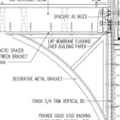Faced vs. Unfaced Fiberglass Insulation for Flat Roof Assembly
Climate Zone 5 – Central Massachusetts & first time homeowner.
About a quarter of my second story is composed of a flat roof dormer. I had the roof replaced this summer, and unfortunately, did not realize the value of hot roof assemblies. There are now two layers of iso rigid foam installed on the exterior of the flat roof, so R-7 or so. The assembly is unvented and the interior cathedral ceilings were previously insulated with fiberglass and a two inch void between the rafters (which promoted mold growth). The rafters are 7.5″ deep and 23″ wide. I intend to keep the system unventilated; apply 3 inches of closed cell spray foam as a moisture barrier to the underside of the roof deck; with fiberglass batting below before drywalling.
And so my question is, should I use faced or unfaced fiberglass insulation above the drywall? I’ve read into facing and I’m honestly not sure where I should and shouldn’t be using it.
GBA Detail Library
A collection of one thousand construction details organized by climate and house part










Replies
Massachusetts is on IRC 2015 I think, which requires a class II vapor retarder (such as facing) on the interior side of frame walls (R702.7). Generally when you've got other vapor retarders in your assembly (like the three inches of closed cell spray foam) the assembly will be safe without the facing on the fiberglass. So, installing faced products for a little extra safety and strict code compliance, but probably fine without it.
Ask your inspector though, as they may consider the spray foam to be NOT on the interior side of the frame wall because it's buried below another insulation product. I've seen it go both ways, only your inspector can know how they are going to treat it.